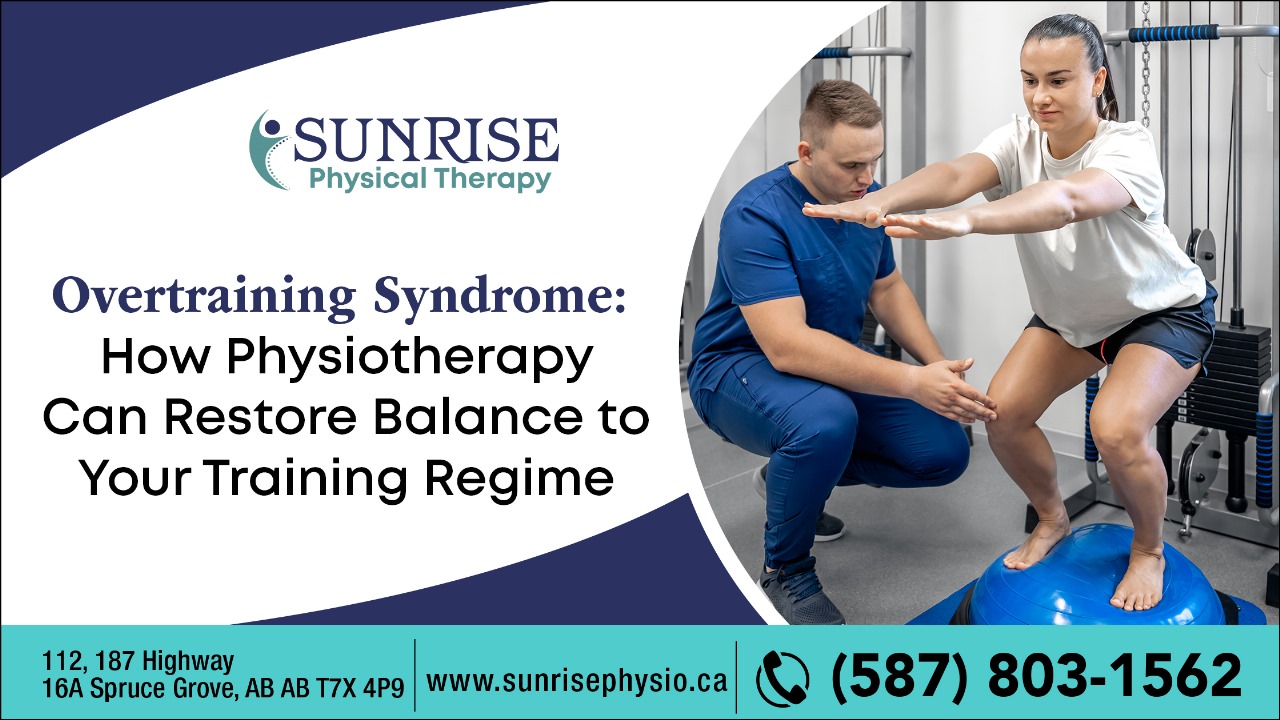Overtraining Syndrome: How Physiotherapy Can Restore Balance to Your Training Regime
Overtraining syndrome is a common challenge among athletes who push their bodies beyond the limits of recovery, leading to diminished performance and increased risk of injury. Recognizing the signs of overtraining is important for any athlete looking to maintain a healthy and effective training regime. Sports physiotherapy in Spruce Grove offers valuable resources for managing these symptoms and guiding athletes toward a balanced approach to training.
Physiotherapists in this field are well-versed in identifying and treating the physical and psychological aspects of overtraining. Integrating strategies focused on overtraining and recovery helps athletes restore their physical health and optimize performance. Whether it’s through tailored exercise programs, rest strategies, or manual therapies, sports injury physiotherapy in Spruce Grove aims to rehabilitate current injuries and also prevent future occurrences by ensuring athletes train smartly and sustainably.
Restoring balance to an athlete’s training regime through sports physiotherapy requires a comprehensive approach that includes assessment and personalized care.
Identifying Overtraining Syndrome
Overtraining can manifest through various physical and psychological symptoms. Recognizing these early signs is crucial for timely intervention.
- Symptoms: Persistent muscle soreness, elevated resting heart rate, insomnia, irritability, and a decrease in performance are typical indicators.
- Assessment: Sports physiotherapists conduct thorough assessments to distinguish between normal training fatigue and overtraining syndrome.
Customized Recovery Strategies
Based on the assessment, physiotherapists design personalized recovery programs that address the needs of the athlete.
- Rest and Recovery: Programs often begin with ensuring enough rest to allow the body to recover. This may include reducing training volume and intensity.
- Rehabilitative Exercises: Light exercises might be introduced to maintain mobility without placing excessive stress on the body.
Restorative Techniques in Sports Physiotherapy
Restorative techniques in sports physiotherapy are essential to help athletes recover from overtraining syndrome and prevent future incidents. Here’s a closer look at each technique and how they are applied:
Active Recovery
Active recovery involves engaging in low-intensity exercise after intense training sessions. The goal is to stimulate circulation and facilitate nutrient delivery and waste product removal from muscles. Activities include walking, light jogging, swimming, or cycling at a low intensity. These exercises help maintain mobility and reduce stiffness without placing additional stress on the body. It is crucial that these activities are truly low-intensity; otherwise, they may contribute to further fatigue rather than aid recovery.
Manual Therapy
Manual therapy in sports physiotherapy includes several hands-on techniques designed to improve tissue extensibility, increase range of motion, induce relaxation, and reduce pain. Key techniques include:
- Massage: Helps relax muscle tension, improve blood flow, and decrease muscle soreness.
- Mobilization: Involves passive movement of joints and soft tissues. It is used to enhance flexibility and align joint structures properly.
- Manipulation: A more aggressive technique that involves applying a rapid, forceful movement to improve the range of motion in a joint. This should only be performed by a skilled practitioner.
These techniques are particularly useful for addressing specific areas of tightness or dysfunction that may develop due to repetitive or excessive training.
Electrotherapy
Electrical energy is used to treat soft tissue injuries, stimulate muscle performance, reduce pain, and accelerate recovery. Common modalities include:
- Ultrasound Therapy: Uses acoustic waves to generate heat deep within muscle tissues, enhancing circulation and aiding the healing process.
- Electrical Stimulation: Techniques like TENS (Transcutaneous Electrical Nerve Stimulation) and NMES (Neuromuscular Electrical Stimulation) are used for pain relief and to stimulate muscle function, respectively. TENS targets nerves to reduce pain sensation, while NMES helps in muscle strengthening and rehabilitation by causing muscle contraction using electrical impulses.
Stress Management Techniques
Managing psychological stress is as important as addressing physical strain.
- Techniques: This includes relaxation practices like yoga, meditation, and deep breathing exercises to help reduce overall stress levels.
- Counselling Support: Some athletes may benefit from counselling to address the psychological aspects of overtraining.
Reintegrating into Training
Gradually reintroducing a structured training regime is crucial to prevent the recurrence of overtraining syndrome.
- Controlled Training Plan: Physiotherapists help athletes gradually increase their training intensity and volume, monitoring for signs of overtraining.
- Continuous Monitoring: Regular follow-ups ensure that the athlete maintains balance in their training routine without slipping back into overtraining patterns.
Education and Training Regime Adjustment
Educating athletes on proper training techniques and the principles of balance in exercise regimens is critical. Key educational points include:
- Understanding Overtraining: Athletes need to recognize the symptoms of overtraining, such as prolonged fatigue, increased susceptibility to illnesses, and decreased performance.
- Adjusting Training Loads: It’s vital for athletes to learn how to balance workload with adequate recovery. Training programs should be adjusted based on feedback from the body, performance metrics, and ongoing dialogue with coaches and physiotherapists.
- Incorporating Varied Training: Including cross-training to promote overall fitness without overloading specific muscle groups.
- Periodization: This involves planning different phases of training (preparation, competition, recovery) to ensure that athletes peak at the right time and have adequate rest.
Achieve Peak Performance with Professional Guidance
At Sunrise Physical Therapy, we offer sports physiotherapy, focusing on helping athletes overcome overtraining syndrome and achieve a balanced training regimen. Our team is committed to assisting you in understanding the signs of overtraining and implementing effective recovery strategies tailored to your specific athletic needs.
Whether you are looking to recover from the impacts of overtraining or aiming to prevent it in your routine, our physiotherapists are here to provide the support and expertise you need.
If you’re struggling with the effects of overtraining and need advice on how to restore balance and enhance your performance, contact Sunrise Physical Therapy. Through sports physiotherapy in Spruce Grove, we can help you train smarter and achieve your peak performance without compromising your health.



